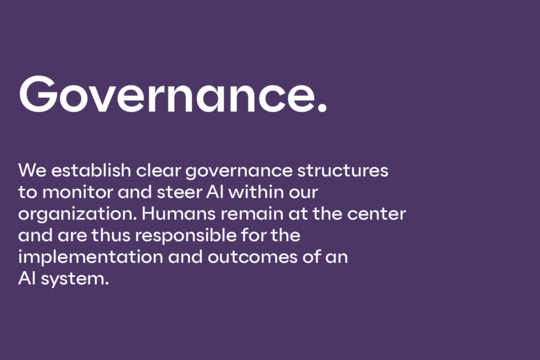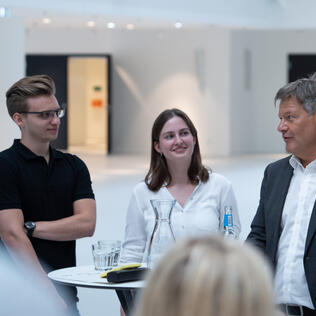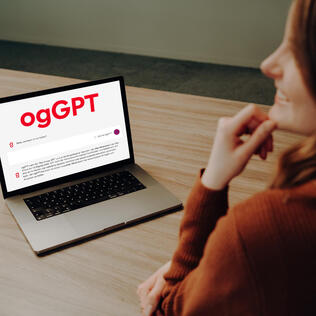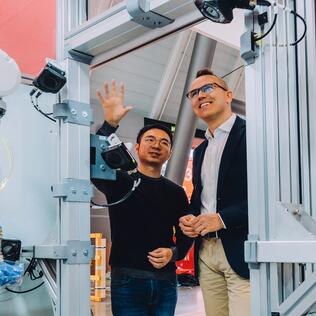Responsibility meets innovation: Responsible AI Guide for the Otto Group

Combining successful business with ecological, social and societal responsibility – there are few topics where this value-orientation is as important as with artificial intelligence (AI). To meet this commitment, the Otto Group has developed a strategic guide for Responsible AI. Five basic principles will guide the responsible use of AI in the future. About the development and relevance of an orientation aid for the AI age.
With the right, customer-focused use cases, artificial intelligence promises great economic potential – not least in retail. The Otto Group recognized this early on and has already established specific applications along its value chains. At the same time, the company is also aware of its responsibility in dealing with this disruptive technology, in line with the shareholder vision "Responsible commerce that inspires". CEO Alexander Birken therefore emphasizes:
AI will have a decisive impact on the e-commerce of the future – if we can trust it. Responsibility is the key to building that trust – a principle that has characterized the Otto Group's actions for decades. Even in the age of AI, this remains unchanged. A responsible approach to AI means combining innovation with ethical principles to shape a sustainable future for all.
On behalf of the Group Executive Board, the Otto Group's Tech Strategy department has developed the "Responsible AI Guide" together with data and AI experts from across the organization. It is intended to serve as a Group-wide compass for the responsible use of artificial intelligence in the future. In this interview, Melissa Kühn from Otto Group Tech Strategy reveals what this means in concrete terms:
Why did you develop this new strategic guide together? What was your motivation?
Melissa: AI is a huge opportunity, but also comes with significant responsibility. We want to ensure that our AI projects are not only technologically advanced and economically viable, but also ethical and responsible. Taking responsibility is part of the Otto Group's DNA. In a new digital era characterized by AI, we see it as our duty to act responsibly here too. The Responsible AI Guide is a practical guide to help you become aware of the many aspects of Responsible AI and put them into practice.
How did you develop the guide? After all, the Otto Group is a decentralized organization, and the needs of the Group companies can vary considerably.
While AI use cases vary depending on the business model, the core principles for Responsible AI can be transferred very well. We have worked closely with AI experts from across the Otto Group to develop the principles and a practical checklist that will help Group companies across the board. The Responsible AI Guide should be seen as a starting point and will be regularly developed and deepened in line with new regulations, technological progress and the experience gained from ethics measures and pilot projects. It was important for us to set a clear direction and set out together as the Otto Group.
What exactly does the guide contain?
The guide is divided into five main principles: Fairness, Transparency, Data Protection, Sustainability and Governance. Each of these principles is supplemented by a checklist with specific recommendations. Fairness is about identifying and minimizing unwanted bias in the data and algorithms, among other things. For example, hidden prejudices and stereotypes in the training data that could then be reproduced by the AI. Transparency, for example, is about making it transparent when a human communicates with an AI and making the decision-making processes as comprehensible as necessary and possible.










At what points in an AI project can the guide come into play?
The guide is intended to serve as a compass for the teams, accompanying them through the entire process of an AI project. It's about thinking about the principles from the outset and regularly checking whether you are on the right track. After all, a responsible approach to artificial intelligence means making decisions based on our values and principles in all project phases – from conception and design to development, implementation, and use. Based on the recommendations in the guide, teams are invited to develop their own processes and structures that suit their way of working and their AI use cases.
And how would we know that the Responsible AI Guide is helpful and therefore successful?
In an ideal world, we would confidently say that all employees are aware of fair and ethical AI, that the decisions of our AI systems are as transparent as possible, and we use AI predominantly to relieve people and conserve resources. Our customers and employees would have more trust in us and our AI products because they know that we use them responsibly.
A lot is currently happening in the field of AI, the speed of development is enormous – how does this affect the guide? What's the next step?
We know that the speed of development is high, and yet disruptive applications of AI are coming even faster than we expected. We are learning more every day about how and for what we can use AI. Regulations and the ability of organizations to transform are not keeping up fast enough. Our Responsible AI Guide is a living document that we regularly review and adapt to keep pace with the latest developments. The basic principles of ethics and responsibility remain, but the discussions about use cases and how best to implement our values will constantly change. It is important that we remain flexible and evaluate new insights and technologies with an open mind.
Thank you so much for these insights, Melissa!

Melissa Kühn works in the Otto Group Holding Tech Strategy department on the Group-wide AI strategy and is an expert in Responsible AI. Her focus is on responsibility, transformation and future technologies. Previously, as Digital Responsibility Manager in the CR department of the Otto Group, she was committed to shaping the company's digital transformation in an environmentally friendly way.





